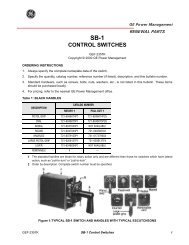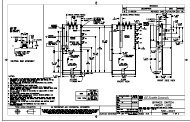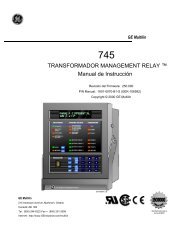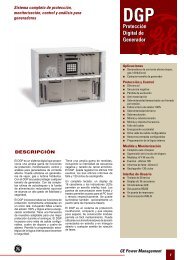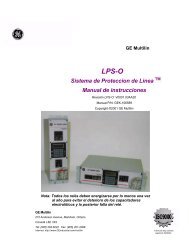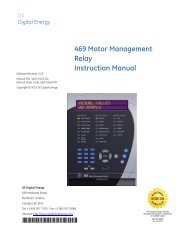Multilin 469 Motor Management Relay ... - GE Digital Energy
Multilin 469 Motor Management Relay ... - GE Digital Energy
Multilin 469 Motor Management Relay ... - GE Digital Energy
Create successful ePaper yourself
Turn your PDF publications into a flip-book with our unique Google optimized e-Paper software.
CHAPTER 5: SETTINGS<br />
5.1.3 <strong>Relay</strong> Assignment Practices<br />
condition that has caused the alarm is still present (e.g. hot RTD) the Alarm relay(s) will<br />
not reset until the condition is no longer present. If on the other hand, an unlatched<br />
alarm feature becomes active, that alarm will reset itself (and associated output<br />
relay(s)) as soon as the condition that caused the alarm ceases. As soon as an alarm<br />
occurs, the alarms messages are updated to reflect the alarm and the <strong>469</strong> display<br />
defaults to that message. Since it may not be desirable to log all alarms as events,<br />
each alarm feature may be programmed to log as an event or not. If an alarm is<br />
programmed to log as an event, when it becomes active, it is automatically logged as<br />
a date and time stamped event.<br />
• BLOCK START: A <strong>469</strong> Block Start prevents or inhibits the start of the motor based on<br />
some logic or algorithm. The Block Start feature is always assigned to the Block Start<br />
relay. In addition to the Trip relay(s), a trip always operates the Block Start relay. If the<br />
condition that has caused the trip is still present (e.g. hot RTD), or there is a lockout<br />
time when the RESET key is pressed, the Block Start relay will not reset until the<br />
condition is no longer present or the lockout time has expired. Blocking features are<br />
always unlatched and reset immediately when conditions that caused the block<br />
cease. In addition to becoming active in conjunction with trips, a block may become<br />
active once the motor stops. There are several features that operate as such: Starts/<br />
Hour, Time Between Starts, Start Inhibit, Restart Block, and <strong>469</strong> Not Programmed.<br />
Block messages are updated to reflect the block when it becomes active (complete<br />
with lockout time if required) and the screen defaults to that message. Blocks are<br />
normally not logged as events. If however, a motor start or start attempt is detected<br />
when a block is active, it is automatically logged as a date and time stamped event.<br />
This scenario might occur if someone shorts across the block terminals and overrides<br />
the <strong>469</strong> protection to start the motor.<br />
There are six output relays. Five of the relays are always non-failsafe, the other (Service) is<br />
failsafe and dedicated to enunciate internal <strong>469</strong> faults (these faults include settings<br />
Corruption, failed hardware components, loss of control power, etc.). One of the output<br />
relays is dedicated as the Block Start relay; it is dedicated to features that are intended to<br />
block motor starting. The four remaining relays may be programmed for different types of<br />
features depending on what is required. One of the relays, 1 TRIP, is intended to be used as<br />
the main trip relay. Another relay, 4 ALARM, is intended to be used as the main alarm relay.<br />
The two relays that are left, 2 AUXILIARY and 3 AUXILIARY, are intended for special<br />
requirements.<br />
When assigning features to Auxiliary <strong>Relay</strong>s 2 and 3, it is a good idea to decide early on<br />
what is required since features that may be assigned may conflict. For example, if<br />
2 AUXILIARY is to be used for upstream trips, it cannot also be used for the control of a<br />
Reduced Voltage Start. Similarly, if 3 AUXILIARY is to be dedicated as a relay to echo all<br />
alarm conditions to a PLC, it cannot also be used strictly to enunciate a specific alarm such<br />
as Undercurrent.<br />
In order to ensure that conflicts in relay assignment do not occur, several precautions have<br />
been taken. All trips with the exception of the Short Circuit Backup Trip default to the 1 TRIP<br />
output relay. All alarms default to the 4 ALARM relay. Only special control functions are<br />
defaulted to Auxiliary <strong>Relay</strong>s 2 and 3. It is recommended that these assignments be<br />
reviewed once all the settings have been programmed.<br />
<strong>469</strong> MOTOR MANA<strong>GE</strong>MENT RELAY – INSTRUCTION MANUAL 5–7










